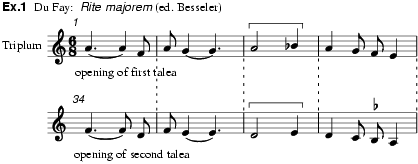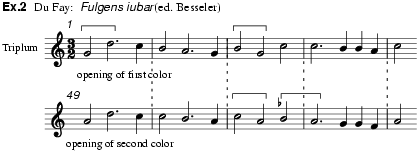
(from Gk. isos: ‘identical’ and melos: ‘melody’; Ger. Isomelie).
A term coined by Heinrich Besseler for the melodic resemblances in the upper parts between different sections of certain isorhythmic motets of the first half of the 15th century. Isomelic recurrence may take place at the beginning of successive taleae and may involve transposition, as in the triplum of Du Fay’s Rite maiorem (ex.1). Since color and talea do not normally overlap in 15th-century motets (by contrast with earlier practice), isomelic resemblance may also be found at the beginning of successive colores, as in the triplum of Du Fay’s Fulgens iubar (ex.2). Isomelism of this kind, also found in music of the Old Hall Manuscript (see Bukofzer), is not related to the cantus firmus. (In this special meaning of coloration, the term was used by E. Reeser.)


Isomelism was once regarded as highly significant, but its importance has since been disputed. Scholars at first interpreted it as a product of conscious compositional procedure: either as a means of ‘symbolizing’ isorhythmic structures, and hence clarifying them (Besseler), or simply as a device which could be inserted in order to mark off isorhythmic sections (Bukofzer, Eggebrecht, Reichert). At the other extreme, Sanders regarded it as a mere by-product of motet composition. More recently, an intermediate view has gained acceptance (see Finscher and Laubenthal).
The majority of melodic connections within motets involve variation rather than strict repetition. It does not seem in such cases that a calculated decision has been made; however, the decision has been not for identity, but against it. In other words: the compositional procedure for the upper parts involves working out certain passages a number of times using variational techniques: the basic contrapuntal outline remains the same each time because of the construction of the tenor part. This is particularly clear in the case of panisorhythmic motets, because of their especially narrow pre-compositional constraints. The technique of variational changes at the openings of successive taleae and colores (which originated either in England or in the Ciconia circle) can therefore be seen as a means of avoiding similarity between sections. In this way it is comparable to certain techniques of cantus firmus coloration (in the sense of diminution).
In some exceptional cases (as in the motetus of O proles Hispanie, probably by Ciconia, and in certain works by Du Fay), upper parts do contain precise repetition of melodic material, and here a conscious compositional decision in favour of isomelism may indeed be inferred. Like so many other highly individual techniques used by motet composers between 1400 and 1450, however (including melodic and rhythmic imitation, duet construction etc.), these must be put down to the subtilitas of the composer; the intention is not to create a separate compositional genre.
(2) Although the term ‘isomelic’ normally refers exclusively to upper parts, it has also been used in connection with certain aspects of color construction and hence with the tenor part, notably by Reeser and Reese.
ReeseMR
H. Besseler: Die Musik des Mittelalters und der Renaissance (Potsdam, 1931), 206
E.Reeser: ‘ Een “iso-melische mis” uit den tijd van Dufay’, TVNM, xvi (1946), 151–2
M.F. Bukofzer: Studies in Medieval and Renaissance Music (New York, 1950)
G. Reichert: ‘ Das Verhältnis zwischen musikalischer und textlicher Struktur in den Motetten Machauts’, AMw, xiii (1956), 197–216
S.E. Brown: ‘ New Evidence of Isomelic Design in Dufay’s Isorhythmic Motets’, JAMS, x (1957), 7–13
H.H. Eggebrecht: ‘Machauts Motette Nr.9’, AMw, xix–xx (1962–3), 281–93; xxv (1968), 173–95; repr. in Sinn und Gehalt: Aufsätze zur musikalischen Analyse (Wilhelmshaven, 1979), 43–105
E.H. Sanders: ‘ The Medieval Motet’, Gattungen der Musik in Einzeldarstellungen: Gedenkschrift Leo Schrade, ed. W. Arlt and others (Berne, 1973), 497–573
L. Finscher and A. Laubenthal: ‘“Cantiones quae vulgo motectae vocantur”: Arten der Motette im 15. und 16. Jahrhundert’, Die Musik des 15. und 16. Jahrhunderts, ed. L. Finscher (Laaber, 1990), ii, 277–370
LAURENZ LÜTTEKEN